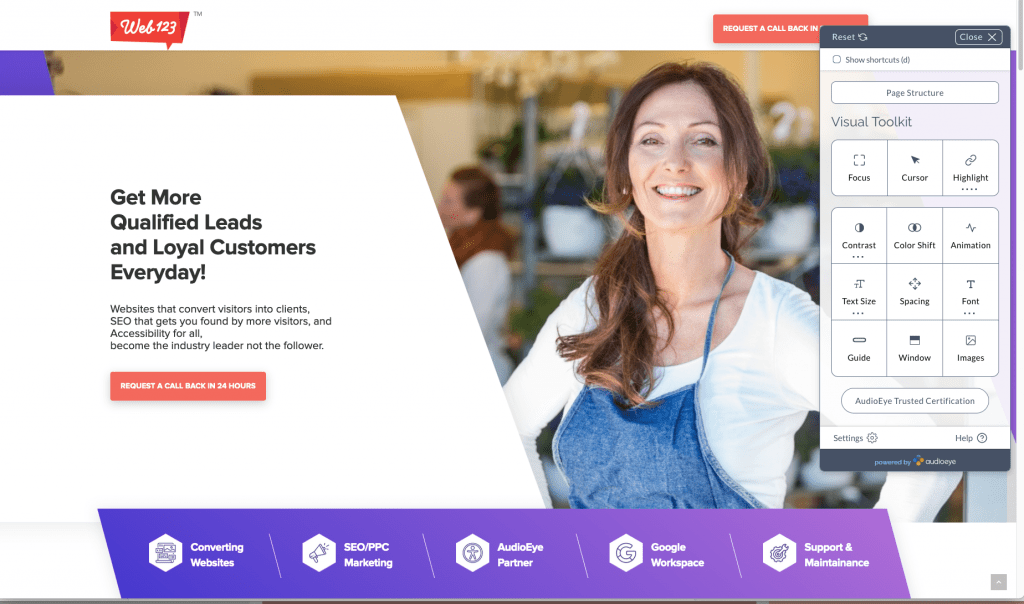A successful website has many things working in harmony – the design, the text, the images, as well as SEO, conversion tactics, and much more.
Often, organisations don’t understand the impact web content accessibility has on its website – and how it can influence SEO and your all-important ranking on Google’s first page of search results.
What is Web Content Accessibility?
Put simply, web content accessibility is making sure your website is accessible for all users.
This is so all website visitors can perceive, operate, understand and interact with your website as it’s intended, including people with a disability.
For example, those with auditory, cognitive, physical, neurological, and visual disabilities, or those with temporary impairments, like a user with a broken wrist or someone recovering from surgery.
It can also cater for accessibility issues like not being able to play audio aloud or being in an area with poor internet connection.
There are also Web Content Accessibility Guidelines (WCAG) that define how to make web content more accessible to people with disabilities.
Why is Web Content Accessibility important?
Web Content Accessibility is important not only for SEO, but also for designing a website in general.
By making your website accessible, you ensure each user can navigate the website, improve the overall experience on your site, and find the information they need.
Accessibility must be considered when approaching your website, because according to the Australian Institute of Health and Welfare:
- Around 1 in 6 people in Australia – 18% or about 4.4 million people – have a disability
- 1 in 3 people with disability have severe or profound disability (32% or about 1.4 million)
- Another 22% of people in Australia have a long-term health condition but no disability.
So not only is web content accessibility important for user experience across the board, but in business, it can also lead to better brand satisfaction, and improved brand loyalty.
How does Web Content Accessibility work with SEO?
While SEO work focuses on how to make websites accessible for search engines, a lot of SEO implementation also make websites more accessible for those with a disability.
Now we’re aware of some of the main factors of web content accessibility and how SEO can work in, let’s look at five easy ways you can improve accessibility while still adhering to all of the required SEO best practices.
1. Page Titles
Page titles help users understand what the page is about, as well as appearing as the main headline in search results.
Screen readers rely on page titles to explain to users when they are navigating between pages.
By optimising page titles for humans so they can easily find what they need, this means you not only adhere to SEO best practice, but web content accessibility as well.
2. Headings
In SEO, the H1 tag provides a main overview for content on the page, while all subsequent tags (H2 – H6) are used to further outline the structure of a page.
Similar to search engine crawlers, assistive technologies, like AudioEye, use headings to navigate a page and move to a particular section of the content.
So, just as in SEO best practice, use only one H1, make sure all headings are relevant to the content that is beneath them, and only use headings if there is content below them.
3. Alt text
Image alt text is one of the most well-known SEO must-haves, and it’s also one that provides web content accessibility. Alt text is used to provide textual alternatives for people with visual impairments.
Alt text is read aloud by screen readers which means they need to be accurate and relevant to the image they are describing, which not only improves accessibility, but your SEO ranking as well.
4. Navigation
Navigation is crucial when it comes to helping users find what they need on your organisation’s website, while also displaying the most important pages of your site.
Navigation links are generally built to be tab-able so all keyboards and screen readers can read them.
Be sure to only include primary pages (rather than the entire site) so your website complies with web content accessibility guidelines.
5. Readability
Ensuring your website content is readable and digestible is important for both users and search engines.
Simplifying your content’s reading level is one of the best ways to help users with cognitive disabilities. This will also help users who are non-native English speakers understand your content more easily.
Testing Accessibility
If you’d like to test the accessibility of your website, Web123 has partnered with AudioEye to provide the digital accessibility tools, services, and expertise you need to build universally accessible web and mobile experiences.

To ensure your website complies with the Web Content Accessibility Guidelines (WCAG), book your free Accessibility Compliance Audit with one of our friendly and knowledgeable Web123 website specialists.
Call us on 1800 932 123 today or click here to send us an email via our Contact page.
